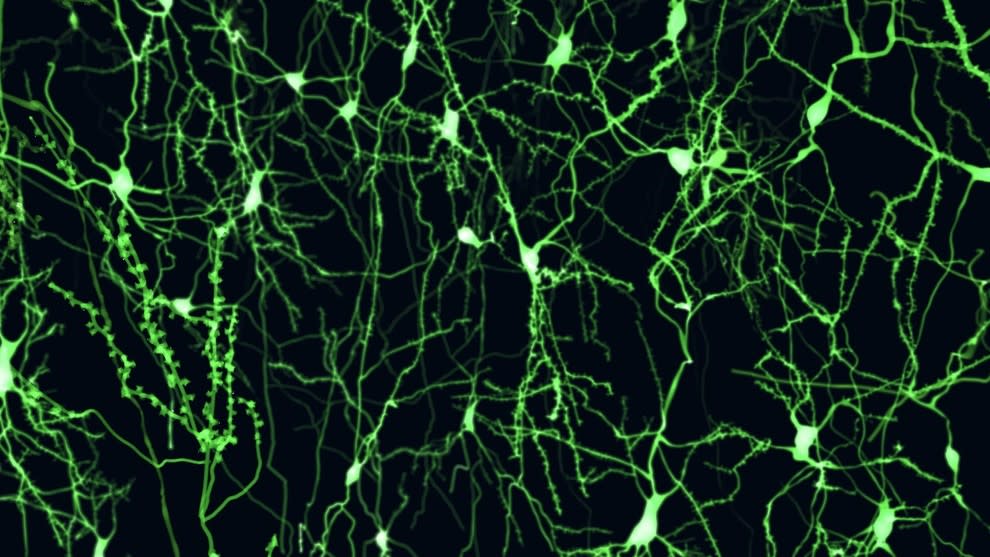- Science News
- Featured news
- Scientists have built an artificial human brain cell
Scientists have built an artificial human brain cell

The model shows that human neurons are fundamentally more powerful in their ability to integrate, process and store information.
The most advanced digital replica of human neurons ever made reveals that human brains are unique — all the way down to their building blocks.
— by Matthew Prior, Frontiers science writer
The most realistic simulation of human brain cells to date provides new insights into our unique intellectual powers. Published in Frontiers in Cellular Neuroscience, the model is the first to integrate fine-scale structural and functional features of ‘pyramidal’ neurons — the main circuit-builder of mammalian brains — from our wrinkled crowning glory, the human neocortex. These digital neurons expose fundamental differences between human and rodent brains, that help explain our enhanced thinking and memory power.
Human brain tissue is pretty hard to come by in research — so most neuroscientists study the brain of mice or rats.
While a huge amount has been learnt this way about how the mammalian brain works at the cellular and circuit level, rodents alone — or any other species — cannot fulfil our quest for self-understanding, for what makes us human. Particularly when it comes to the neocortex.
Human Cortical Pyramidal Neurons: From Spines to Spikes via Models► Read original article► Download original article (pdf)
The human brain’s advanced cognitive capabilities are often attributed to this most recently evolved structure: its iconic folded surface. Comparison of human and rodent brains shows that the human neocortex has a thousand-fold more nerve cells, is 50% thicker with more neuronal connections per cell, and its principal computational building blocks or “microchips” — pyramidal neurons — are larger. Is this purely a matter of size, or might our neurons also differ in other ways?
“To really understand how our own brain works and ‘what makes us human’, it is essential to study the human brain at the fine-grain level of cells and the connections that they make with other cells — the synapses” argues Professor Idan Segev of the Hebrew University of Jerusalem, Israel. “But this is very challenging, because of ethical and technical constraints.”
Now, thanks to the generosity of a small number of human brain tissue donors and the ingenuity of Segev’s multidisciplinary team of collaborators, a new solution is forming — one neuron at a time.
“To overcome these limitations, we built realistic working 3D computer models of human neocortical pyramidal cells and determined what makes them unique.
By endowing the virtual cells with detailed features of real human neurons observed in fresh surgical biopsies and fixed postmortem tissue, the researchers were able to fill in the gaps left by these rare experimental data.
“Previous experimental work already identified several anatomical and physiological differences between pyramidal neurons in humans and rodents,” explains Segev.
For example, the dendrites — the part of the neuron that receives inputs from other nerve cells — are more intensely branched in humans and they receive many more synapses, around 30,000, per cell as compared to ~10,000 in rodents. Human pyramidal neurons also have a much lower specific capacitance compared to rodents’, meaning that they generate electrical signals more readily and transmit them faster and more efficiently.
“Our new detailed digital model for human cortical pyramidal neurons is the first ever to integrate these distinct anatomical and physiological features — allowing us to identify several new properties of human neurons — and to analyze their functional implications using advanced computational tools.
The new properties revealed by these computer models help explain how human pyramidal neurons process efficiently their especially large number of synaptic inputs, aided by their lower membrane capacitance and more powerful synaptic inputs compared to rodents’ neurons.
“Human cortical cells have unique membrane properties, with more efficacious excitatory synapses that compensate for their highly-branched and elongated dendritic tree, and strong local dendritic nonlinearities; together these properties boost their computational power.”
In other words, when a dendrite receives multiple signals simultaneously, it does not simply add these together to send on to the cell body — but instead adds another computational step to signal integration within the neuron.
Related: Breakthrough in construction of computers for mimicking human brain
“This suggests that human neurons are not just a stretched-out version of the respective rodents’ neurons, but that they are fundamentally more powerful in their ability to integrate, process and store information.”
One key prediction arising from the model is that the information storage capacity, or memory, of human pyramidal neurons is nearly four times higher than those of rats. This is because human cells not only have around three times more synapses than the respective rodent cells, but can also support nearly double the number of simultaneous, independent “local dendritic spikes” — the voltage signals that enable synaptic inputs to be conveyed from the dendrite to the cell body. This multi-site local signal processing in human dendrites also helps to explain the enhanced computational capability of these cells.
“Our models are still based on a number of assumptions — we need a lot more data to fully model human neurons, and the cortical circuits that they form” cautions Segev. “Eventually, we will need to build a detailed model of the whole human brain, including its different neuron types, if we want to understand what makes us human.”
The study serves as a baseline reference for future efforts to understand human neurons, which could contribute to improved treatments for brain diseases. The model could also help researchers to develop brain-inspired learning machines and develop Artificial Intelligence.
“The human brain is an advanced technology with unique capabilities,” says Segev. “In the next decade we will see a growing effort worldwide to understand the human brain at the local circuit level. We’re now beginning to understand the cellular-level details of what separates us from other species — and exploring how this understanding can be applied for developing human-specific brain medications and human-brain inspired technologies. These are highly exciting times for brain researchers and for human kind in general!”
Original article: Human Cortical Pyramidal Neurons: From Spines to Spikes via Models
REPUBLISHING GUIDELINES: Open access and sharing research is part of Frontiers’ mission. Unless otherwise noted, you can republish articles posted in the Frontiers news blog — as long as you include a link back to the original research. Selling the articles is not allowed.







